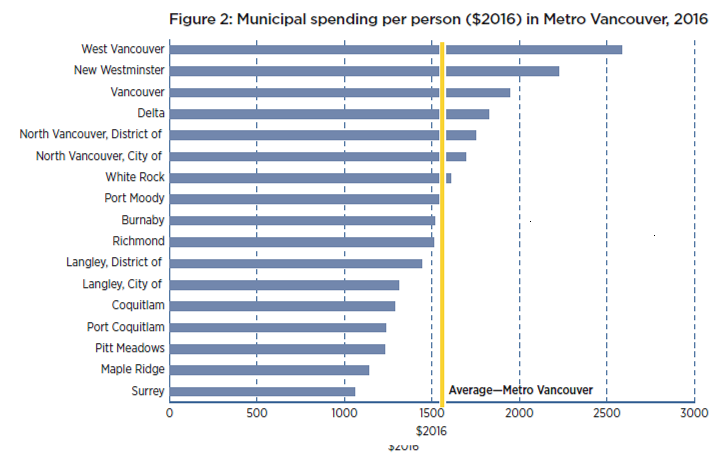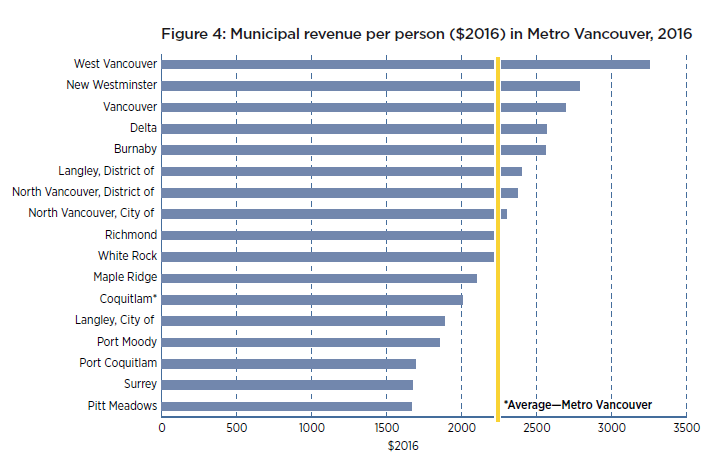I never want to react to the Fraser Institute. The easy ad hominem attack is that they are the Canadian propaganda wing of Koch Brothers enterprises, and their attempts to shift public policy in Canada should raise concern, but the more substantive attack is that they produce terrible reports that would not earn a passing grade if they were handed in as an Economics 101 term paper. They are bad at data, so it is best if we ignore them.
Alas, I was asked by an intrepid local reporter to comment because the City of New Westminster is made to look fiscally irresponsible in their latest fresh-off-the-presses piece of decontextualized tripe, so I did a bit of a dive into the numbers. This turned into several hours of trying to reverse-math their numbers, because like the failing university economics students they resemble, they don’t actually provide raw data or point clearly to what their data sources are, instead providing derived numbers without the benefit of showing their calculations. They are bad at reporting data, and we should probably ignore them.
I dug around in the BC Government website they link to as a data source (this one), and after figuring out how they got all of the population for 2016 wrong (using projected estimates instead of readily-available Census data), I started to dig through the various tables and repeated calculations until I got results mimicking theirs. They primarily used “spending data” from this table, and “revenue data” from this table. But they clearly didn’t know (or didn’t care) that New Westminster’s data includes the financial reporting by our Electrical Utility. They are bad at interpreting the data they have, so it is best we just ignore them.
For context, New Westminster operates its own Electrical Utility. It has since before BC Hydro existed. We hold on to it because it is a great deal for the residents of New Westminster. Using 2016 numbers to be consistent with the Fraser Institute report (See Page 90 of this report for the utility’s 2017 numbers), our Electrical Utility sells about $45,000,000 worth of electricity to residents and businesses in the City, at the same rate (more or less) as those customers would pay BC Hydro if they were in another Municipality. It costs the utility about $33,000,000 to purchase that electricity from BC Hydro at bulk wholesale rates. About half of that difference goes into operating the utility (paying staff, buying wires and building substations) and the other half is paid to the City as a dividend. We are the only Municipality in the lower mainland that does this, so we are the only municipality that includes these numbers in their expenses and revenue tables. This is important context. The Fraser Institute is bad at context, which is why we would all be better off by ignoring them.
Because of this bug in the data, their report suggests that New Westminster has “the second highest municipal spending” per capita, along with “the second highest municipal revenue” per capita. They even have bar charts to prove it:


The problem being, New Westminster’s electrical utility “spends” about $38 Million a year, and it generates about $45 Million in revenue. If you take this into account, those bar charts look very different:


The shorter and more accurate story here is that New Westminster (outside of the electrical utility) spends slightly above the regional average on a per capita basis, and collects slightly less than the regional average in taxation and fee revenue. Think about that for a minute.
“Spending” in the local government context means putting police officers on the street, mowing lawns in our parks, and providing swimming lessons to your kids. The money we spend is providing services to our residents, and we do that at a slightly higher rate than the regional average. At the same time, the revenue we collect from our residents in the form of taxes and fees is lower than the regional average. An alternate Fraser Institute headline may be: New Westminster delivers more for less!
Ironically, part of the reason we deliver more for less is the electrical utility that can buy electricity for wholesale, sell it for retail, and provide a dividend to the City which we can use to provide services that would otherwise need to be paid for through taxes. Arguably, having an electrical utility is the most entrepreneurial thing we do, and is something that the entire “run government more like a business” Fraser Institute crowd would normally celebrate.
There is more in this report, including tables showing the City’s residential taxes are below average for the region (12th highest of 17 municipalities), and our debt servicing costs are average, but that kind of story – “City is about average” – doesn’t make for a very exciting headline.

Alas, New Westminster is just kind of average. And when it comes to managing finances, this is not a bad thing. Every financial decision is about balancing the cost with the priorities our residents and businesses expect us to address. I am proud of the level of service we provide in New Westminster, and our ability to do that while keeping taxes below the regional average.
Thank you once again Pat for providing the kind of transparency and analysis that allows us as citizens to make informed choices choices based on the information available to us. As a taxpayer and the resident I can tell you that I am happy with the value we receive for our tax dollars here in New Westminster, and I credit not only the city administration and staff, but the governance priorities of the mayor and council. Job well done!
Thanks for taking the time to help us better understand this matter. Your work indicates the Fraser Institute made an obvious mistake. They’re not admitting it indicates it was likely intentional.